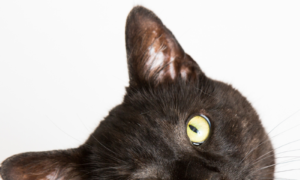Those that don’t really know cats, even some cat guardians that aren’t fully informed often have misconceptions about cats. Here are four common cat  myths and the facts to dispel each one:
myths and the facts to dispel each one:
Cat Myth 1: Declawing is minor and doesn’t hurt cats.
This is a dangerous misconception, since the declaw procedure involves amputating a portion of a cat’s paws, comparable to cutting off a finger at the first knuckle. Several countries including England, Spain, Italy, Australia and New Zealand have laws making the procedure illegal. Once declawed, the way a cat walks is often impacted, and cats may suffer lifelong health problems such as arthritis. Rather than declawing a cat, it’s important to have scratching surfaces available for them. There are also claw tips that can be applied to cat’s nails to prevent damage to furniture, or a type of double sided tape that makes it difficult for cats to remove paws from it if they get the urge to scratch in an inappropriate spot. To learn more about the declaw procedure, go to pawproject.org
Cat Myth 2: Cats are jerks.
This statement is made often online, and it irritates me very time I see it. Cats aren’t jerks, they’re just often misunderstood. Since cats aren’t able to speak to us, their communication is often their instinctual actions. When a cat pees outside his litter box, he’s not being spiteful, but rather indicating something isn’t “right” with the box, or cats often do this as a means of letting us know something is physically wrong. If your cat bites you when you’ve been petting him for a while, he probably gave you signs he’d had enough and you didn’t heed his warnings through body language, or might not know what those signs are that he’s giving.
Cat Myth 3: Cats are low maintenance pets.
It’s true, most cats don’t go outside for walks and they do tend to sleep much of the time, but that doesn’t mean they don’t need some of your time. Cats need mental stimulation to prevent them from getting bored and developing destructive behaviors such as inappropriate scratching of furniture. They also need physical stimulation to burn off excess energy and help maintain a healthy weight. If possible, schedule a couple of daily play sessions with your cat. Keep the sessions short, 15 minutes seems to be a good length of time to hold cat’s attention. Have a play session in the morning and one in the evening. Wand toys work very well, since your cat is able to simulate hunting and will consider the toy his prey. Change out the toys you play regularly, since cats can have a tendency to get bored rather quickly. When a toy comes up again in the rotation, your cat will think of it as new and have a newfound appreciation for it.
Cat Myth 4: Black Cats Are Bad Luck
The old superstitions that black cats are bad luck persists today, and as a result black cats are often the slowest to be adopted and first to be euthanized. They’re a different color, but they’re still cats with all the special traits that make cats who they are. Black cats have a gleam to their coats that isn’t as obvious in cats of other colors. All the black cats I know are quite characters, too, with great personalities. We don’t like discrimination of humans based on skin color, it would be great if we looked at black cats the same way. Is there a rescue in your area dedicated to black cat adoptions? If so, consider volunteering with them.
If you encounter someone that believes any of these common cat myths to be true, consider taking a moment to give them the accurate information to hopefully put these harmful beliefs to rest. Cats are great companions, and educating others about them is a step in right direction to helping more people appreciate cats.





